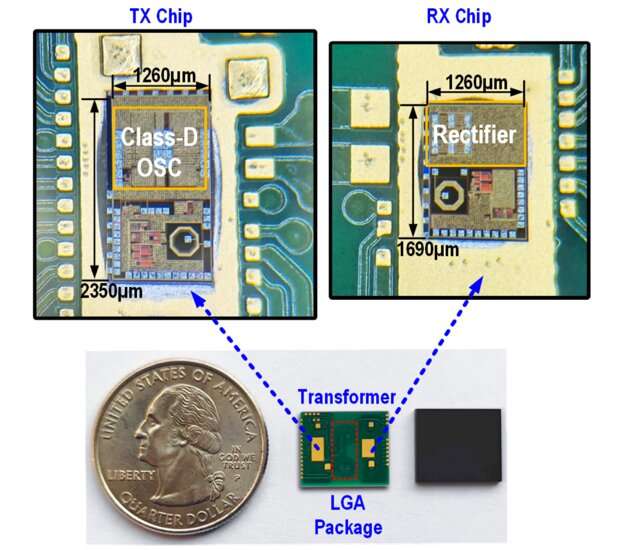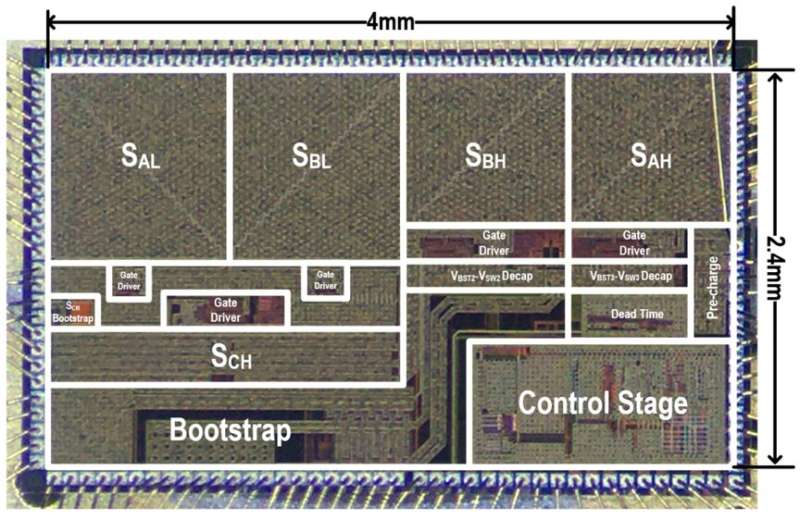Die micrograph of the RX and the TX chips and a photo of the converter in an LGA package. Credit: Pan Dongfang et al
The research team led by Prof. Cheng Lin from the School of Microelectronics, University of Science and Technology of China (USTC) of the Chinese Academy of Sciences (CAS), has developed two power management integrated circuits with low electromagnetic interference (EMI) and fast transient responses. Both circuits were presented at the IEEE International Solid-State Circuits Conference (ISSCC), the top conference in integrated circuit design.
High-efficiency isolated power circuit with low EMI
The frequency of the internal power oscillation signal and the power density of circuits become higher as the size of the isolated power is made to be smaller. Isolated DC-DC converters tend to act as sources of radiation, which would raise EMI issues. Conventional isolated DC-DC converters reduce EMI by modifying internal layers, which would incur high expense and always fail to eliminate EMI at its origin. Therefore, it is an urgent need to develop a low-cost circuit capable of reducing EMI at the source.
In this work, researchers provided a symmetrical transmitter topology of Class-D oscillator, which can reduce the common-mode (CM) current of the isolated power system, to lower EMI radiation. Besides, dead-time control was applied in this study to avoid the shoot-through current effectively. In addition, by reducing the voltage stress of the power transistor, the conversion efficiency of the oscillation was effectively improved, thereby decreasing the cost of the circuit.
The die micrograph of the DSD converter. Credit: Yuan Jingyi et al
Efficiency measurement results showed that the circuit achieved a peak efficiency of 51% and a maximum output power of 1.2W, and its EMI performance passed the CISPR 32 standard.
High conversion ratio DC-DC converter circuit
Single-stage high conversion ratio DC-DC converter, due to its advantages of low transmission loss and high comprehensive efficiency, has broad application prospects in data centers and 5G communication base stations. Currently, high conversion ratio DC-DC converters generally use a topology combining a multi-phase DC-DC converter and a series capacitor to achieve the expansion of the equivalent conversion ratio. However, the speed of its load transient response is limited by the inability to turn on multiple phases simultaneously.
In this study, based on the topology of a dual-phase series capacitor DC-DC convertor, a voltage-mode PWM controller with two feedback loops was proposed to realize the modulation of the output voltage and the series capacitor voltage. Researchers also proposed a fast transient response technology, which not only overcame the shortcomings of the traditional PWM control in terms of loop response speed and load transition time, but also used dual-phase inductor current to simultaneously charge the load to further improve the response speed of the converter.
The measured load-transient responses with the proposed dual-phase charging technique showed a settling time of only 0.9μs, which is the fastest transient responses in all current studies by far.
More information: Conference: www.isscc.org/
Provided by University of Science and Technology of China
























